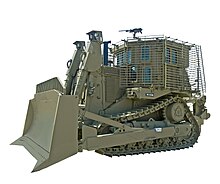Cage armor
As slat armor ( English slat armor , cage armor , bar armor or standoff armor ) is called an additional protection for the armor of mostly military vehicles.
functionality
A solid metal cage construction around the vehicle should detonate shaped charge projectiles ( e.g. from anti-tank weapons such as the RPG-7 ) before hitting the actual armor, so that the warhead can no longer develop its full penetrating power. The advantage of this concept lies in the weight savings and the continued guaranteed mobility of the vehicle compared to other additional armor. The disadvantage lies in the comparatively low protection spectrum: the cage armor only works against shaped charge projectiles, while other types of ammunition are not affected.
From 2007 the British BAE Systems developed a lightweight aluminum construction (LROD or L-ROD). According to the company, this is only half as heavy as conventional steel cages, but can guarantee the same protection and, according to the manufacturer, is used by the US Army, among others.
application
Cage armor was introduced during World War II to counter the threat posed by anti-tank handguns of the Panzerfaust and Bazooka types .
The side skirts made of solid steel plates, which were mainly used for Panzerkampfwagen III , IV and assault guns, were made from thick wire mesh from the end of 1943.
At the end of the war in Berlin, some Soviet T-34 / 85s were also equipped with mesh on the hull and turret, which were supposed to help against German bazookas. Something similar is known from the allies who attached the wire mesh from small animal cages to their tanks near Paris in order to have protection against shaped charges and bazookas. The tanks were therefore very eye-catching.
Allied forces resorted to cage armor during the Iraq war to neutralize the ongoing threat posed by insurgent RPG-7s . This protection concept is mainly used in vehicles of the Force Protection Buffalo MPV , MRAP Category III, General Dynamics Stryker Armored Vehicle and the Warrior armored personnel carrier.
The Leopard 2A6M and Bergepanzer Büffel (BPz 3) tanks of the German Armed Forces borrowed from the Canadian armed forces for use in Afghanistan were also provided with cage armor.
Individual evidence
- ↑ The MRAP Cage Fight ( Memento from January 19, 2008 in the Internet Archive )
- ↑ L-ROD Cage Armor ( page no longer available , search in web archives ) Info: The link was automatically marked as defective. Please check the link according to the instructions and then remove this notice. (English, August 17, 2012)


